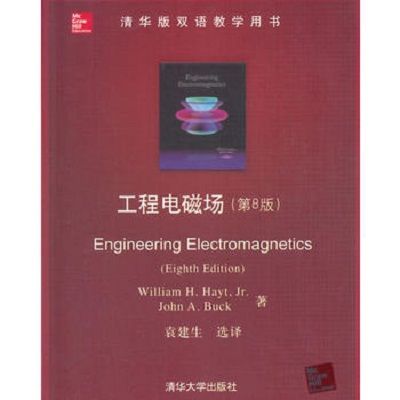內容簡介
本教材與國內電子與電氣工程專業的本科教材基本一致,其內容滿足我國高校教學大綱要求。該書基本概念講述清晰、注重物理概念、淡化公式推導、圖文並茂、定理和重要公式彩色加重印刷; 每章後面都配有約30道習題。該書寫作文筆流暢、可讀性好、易理解,學生可以使用該教材進行自主學習,是電磁場或電磁場與波課程的理想教材或參考書。
目錄
AbouttheAuthors1
序3
Chapter1
VectorAnalysis2
I.IScalarsandVectors2
1.2VectorAlgebra3
1.3TheRectangularCoordinateSystem4
1.4VectorComponentsandUnitVectors6
1.5TheVectorField
1.6TheDotProductl0
1.7TheCrossProduct12
1.80therCoordinateSystems:Circular
CylindricalCoordinates14
1.9TheSphericalCoordinateSysieml9
References23
Chapter1Problems23
Chapter2
Coulomb'sLawandElectric
FieldIntensity28
2.1TheExperimentalLawofCoulomb28
2.2ElectricFieldIntensity31
2.3FieldArisingfromaContinuousVolume
ChargeDistribution35
2.4FieldofaLineCharge37
2.5FieldofaSheerofCharge41
2.6StreamlinesandSketchesofFields43
References46
Chapcer2Problems46
Chapter3
ElectricFluxDensity,Gauss'sLaw,
andDivergence51
3.1ElectricFluxDensity51
3.2Gauss'sLaw55
3.3ApplicationofGauss'sLaw:Some
SymmetricalChargeDistributions59
3.4ApplicationofGauss'sLaw:Differential
VolumeElement64
3.5DivergenceandMaxwell'sFirstEquation67
3.6TheVectorOperatorVandtheDivergence
Theorem70
References7:3
Chapter3Problems74
Chapter4
EnergyandPotential79
41EnergyExpendedinMovingaPointChargein
anElectricField80
4.2TheLineIntegralSl
4.3DefinitionofPotentialDifference
andPotential86
4.4ThePotentialFieldofaPointCharge88
4.5ThePotentialFieldofaSystemofCharges:
ConservativeProperty90
4.6PorentialGradient94
4.7TheElectricDipole99
4.8EnergyDensityintheElectrostatic
Field104
References108
Chapter4Problems109
Chapter5
ConductorsandDielectrics114
5.1CurrentandCurrentDensity115
5.2ContinuityofCurrent116
5.3MetallicConductors119
5.4ConductorPropertiesandBoundary
Conditions124
5.5TheMethodofImages129
5.6Semiconductors131
5.7TheNatureofDielectricMaterials132
5.8BoundaryConditionsforPerfect
DielectricMaterialsI38
References142
Chapter5Problems143
Chapter6
Capacitance149
6.1CapacitanceDefined149
6.2Parallel-PlateCapacitor151
6.3SeveralCapacitanceExamples153
6.4CapacitanceofaTwo-WireLine156
6.5UsingFieldSketchestoEstimate
CapacitanceinTwo-Dimensional
Problems160
6.6Poisson'sandLaplace'sEquations166
6.7ExamplesoftheSolutionofLaplace's
Equation168
6.8ExampleoftHeSolutionofPoisson's
Equation:Lhep-nJunctionCapacitance175
References178
Chapter6Problems179
Chapter7
TheSteadyMagneticField187
7.1Biot-SavartLaw187
7.2Ampere'sCircuitalLaw195
7.3Curl202
7.4Stokes'Theorem209
7.5MagneticFluxandMagneticFlux
Density214
7.6TheScalarandVectorMagnetic
Potentials217
7.7DerivationoftheSteady-Magnetic-Field
Laws224
References230
Chapter7Problems230
Chapter8
MagneticForces,Materials,
andInductance238
8.1ForceonaMovingCharge238
8.2ForceonaDifferentialCurrentElement240
8.3ForcebetweenDifferentialCurrent
Elements244
8.4ForceandTorqueonaClosedCircuit246
8.5TheNatureofMagneticMaterials252
8.6MagnetizationandPermeability255
8.7MagneticBoundaryConditions260
8.8TheMagneticCircuit263
8.9PotentialEnergyandForcesonMagnetic
Materials269
8.10InductanceandMutualInductance271
References278
Chapter8Problems278
Chapter9
Time-VaryingFieldsandMaxwell's
Equations286
9.1Faraday'sLaw286
9.2DisplacementCurrent293
9.3Maxwell'sEquationsinPointForm297
9.4Maxwell'sEquationsinIntegralForm299
9.5TheRetardedPotentials301
References305
Chapter9Problems305
Chapter10
TransmissionLines311
10.1PhysicalDescriptionorTransmissionLine
Propagation312
10.2TheTransmissionLineEquations314
10.3LosslessPropagation316
10.4LosslessPropagationofSinusoidal
Voltages319
10.5ComplexAnalysisofSinusoidalWaves321
10.6TransmissionLineEquationsandTheir
SolutionsinPhasorForm323
10.7Low-LossPropagation325
IO.SPowerTransmissionandTheUseofDecibels
inLossCharacterization327
10.9WaveReflectionatDiscontinuities330
10.10VoltageStandingWaveRatio333
10.11TransmissionLinesofFiniteLength337
10.12SomeTransmissionLineExamples340
10.13GraphicalMethods:TheSmithChart344
10.14TransientAnalysis355
References368
Chapter10Problems368
Chapter11
TheUniformPlaneWave378
11.1WavePropagaitioninFreeSpace378
11.2WavePropagaitioninDielectrics386
11.3Poynting'sTheoremandWavePower395
11.4PropagationinGoodConductors:
SkinEffect398
11.5WavePolarization405
References412
Chapter11Problems412
Chapter12
PlaneWaveReflectionand
Dispersion418
12.1ReflectionofUniformPlaneWaves
atNormalIncidence418
12.2StandingWaveRatio425
12.3WaveReflectionfromMultiple
Interfaces429
12.4PlaneWavePropagationinGeneral
Directions437
12.5PlaneWaveRelflectionatObliqueIncidence
Angles440
12.6TotalReflectionandTotalTransmission
ofObliquelyIncidentWaves446
12.7WavePropagationinDispersiveMedia449
12.8PulseBroadeninginDispersiveMedia45t
References459
Chapter12Problems460
Chapter13
GuidedWaves466
13.1TransmissionLineFieldsandPrimary
Constants466
132BasicWaveguideOperation476
13.3PlaneWaveAnalysisoftheParallel-Plate
Waveguide480
13.4Parallel-PlateGuideAnalysisUsingtheWave
Equation489
135RectangularWaveguides492
13.6PlanarDielectricWaveguides503
1370pticalFiber510
References519
Chapter13Problems520
Chapter14
ElectromagneticRadiation
andAntennas525
14.1BasicRadiationPrinciples:TheHertzian
Dipole525
14.2AntennaSpecifications532
14.3MagneticDipole537
14.4ThinWireAntennas139
14.5ArraysofTwoElements147
14.6UniformLinearArrays551
14.7AntennasasReceivers555
References562
Chapter14Problems162
AppendixA
VectorAnalysis567
A.lGeneralCurvilinearCoordinates567
A.2Divergence.Gradient.andCurl
inGeneralCurvilinearCoordinates568
A.3VectorIdentities570
AppendixB
Units571
AppendixC
MaterialConstants576
AppendixD
TheUniquenessTheorem579
AppendixE
OriginsoftheComplex
Permittivity581
AppendixF
AnswerstoOdd-Numbered
Problems588
第1章矢量分析2
l.l標量和矢量2
1.2矢量代數3
1.3直角坐標系4
1.4矢量的分量與單位矢量6
1.5矢量場9
1.6點乘10
1.7叉乘12
1.8其他坐標系:圓柱坐標14
1.9球坐標系19
參考文獻23
習題23
第2章庫侖定律和電場強度28
2.1庫侖實驗定律28
2.2電場強度3l
2.3連續體電荷分布的場35
2.4線電荷的場37
2.5面電荷的場41
2.6場線和場圖43
參考文獻46
習題46
第3章電通量密度、高斯定理
和散度51
3.1電通量密度51
3.2高斯定理55
3.3高斯定理的套用:幾種對稱電荷分布59
3.4高斯定理的套用:體微元64
3.5散度和麥克斯韋第一方程67
3.6矢量運算元V和散度定理70
參考文獻73
習題74
第4章能量和電位79
4.1電場中移動一個點電荷消耗的能量80
4.2線積分8l
4.3電位差和電位的定義86
44點電荷的電位場88
4.5電荷系統的電位場:保守特性90
4.6電位梯度94
4.7電偶極子99
4.8靜電場的能量密度104
參考文獻108
習題109
第5章導體和介質114
5.1電流和電流密度115
5.2電流的連續性116
5.3金屬導體119
5.4導體特性和邊界條件124
5.5鏡像法129
5.6半導體131
5.7介質材料的性質132
5.8理想介質材料的邊界條件138
參考文獻142
習題l43
第6章電容149
6.1電容定義149
6.2平行板電容器151
6.3幾個電容實例153
6.4雙導線電容156
6.5二維問題中用電場圖估算電容160
6.6泊松和拉普拉斯方程166
6.7拉普拉斯方程求解實例168
6.8泊松方程求解實例:p一n結電容175
參考文獻178
習題179
第7章恆定磁場187
7.1畢奧一薩伐爾定律187
7.2安培環路定律195
7.3旋度202
7.4斯托克斯定理209
7.5磁通和磁通密度214
7.6標量和矢量磁位217
7.7恆定磁場定律的推導224
參普文獻230
習題230
第8章磁場力、材料和電感238
8.1運動電荷所受的力238
8.2微電流元所受的力240
8.3兩個微電流元之間的力244
8.4閉合電路所受的力和力矩246
8.5磁材料的性質252
8.6磁化和磁導率255
8.7磁邊界條件260
8.8磁路263
8.9磁能和磁材料所受的力269
8.10電感和互感271
參考文獻278
習題278
第9章時變場和麥克斯韋方程組286
9.1法拉第定律286
9.2位移電流293
9.4麥克斯韋方程組的積分形式299
9.5推遲位301
參考文獻305
習題305
第10章傳輸線311
10.1傳輸線傳播的物理描述312
10.2傳輸線方程314
10.3無損傳播316
10.4正弦電壓的無損傳播319
10.5正弦波的複數分析321
10.6相量形式的傳輸線方程及其解323
10.7低損耗傳播325
10.8損耗特性下的功率傳輸和
分貝的使用327
10.9不連續處的渡反射330
10.11有限長傳輸線337
10.12幾個傳輸線實例340
10.13圖解法:史密斯圖344
10.14暫態分析355
參考文獻368
習題368
第11章均勻平面波378
11.1自由空間中的波傳播378
11.2介質中的渡傳播386
11.3坡印亭定理和波功率395
11.4良導體中的傳播:趨膚效應398
11.5波的極化405
參考文獻412
習題412
第12章平面波反射和色散418
12.2駐波比425
12.3多個界面的渡反射429
12.4一般方向的平面波傳播437
12.5斜入射波角時的平面渡反射440
12.6斜入射波的全反射與全傳輸446
12.7色散媒質中的波傳播449
12.8色散媒質中的脈衝變寬現象455
參考文獻459
習題460
第13章導波466
13.1傳輸線場和基本參數466
13.2基本波導工作原理476
13.3平行板波導的平面波分析480
13.4用波方程進行平行板波導分析489
13.5矩形波導492
13.6平面介質波導503
13.7光纖510
參考文獻519
習題520
第14章電磁輻射與天線525
14.1基本輻射原理:赫茲偶極子525
14.2天線描述參數532
14.3磁偶極子537
14.4細導線天線539
14.5二元陣列天線547
14.6均勻線性陣列天線551
14.7作為接收器的天線555
參考文獻562
習題562
附錄A矢量分析567
A.l-般曲線坐標567
A.2-般曲線坐標下的散度、梯度
和旋度568
A.3矢量恆等式570
附錄8單位571
附錄C材料常數576
附錄D唯一性定理579
附錄E復介電常數的根源581
附錄F奇數號習題答案588

